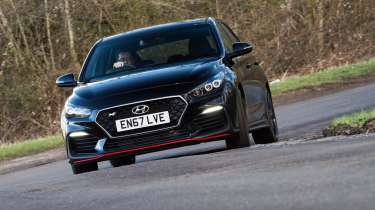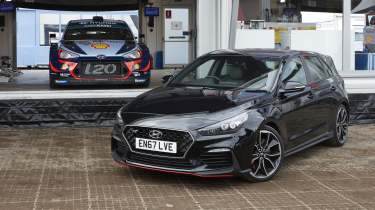Hyundai i30 N Fast Fleet test – 8 months with the Korean hot hatch
The i30 N has been one of our favourite hot hatches ever since we first sampled it. It passed the long-term test with flying colours, too
Back in March 2017 I handed back the key to my very first long-term car, a Kia Proceed GT. I summed up my final report by suggesting that while it was an easy car to appreciate, its lack of character – bright yellow paintwork aside – made it a hard one to love. ‘When Kia produces a car that you look forward to driving,’ I summarised, ‘its rivals really will have something to worry about.’
I’m not claiming any Nostradamus-style powers of prescience, but both Kia and sister brand Hyundai did exactly that. What we didn’t know at the time was that Kia’s moonshot would be a high-performance, rear-wheel-drive saloon to make a 340i feel dull (the Stinger GT S), and that it would be Hyundai giving established hot hatch rivals from Volkswagen and Peugeot a fright under its ‘N’ performance brand.
> Renault Sport Megane R26.R (2009): the most significant hot hatch of the last 25 years
If you kept up to date with our i30 N’s exploits, there’ll be no spoilers with my verdict: it’s brilliant. As entertaining and engaging as it is easy to live with, it blows aside any concerns I had with that old Proceed GT in one blast of its twin tailpipes. Where the Kia played it safe, the Hyundai grabs you by the scruff and drags you into the action. Our car arrived in Performance trim, with the full 271bhp, 19-inch P Zero-wrapped wheels, an electronically controlled limited-slip differential, active exhaust and uprated brakes.
More reviews
It’s worth it for the exhaust alone, frankly. To my ears no modern hot hatch sounds better at full chat, and while its burbles and parps sounded feeble next to a proper i20 WRC when I drove the i30 to Rallye Deutschland, the cacophony was gloriously welcome every time a twisty stretch opened up in front of me.
Despite the huge range of adjustment in virtually every one of the N’s customisable parameters, I settled on pretty much my perfect combination in the first couple of weeks – everything drivetrain-related (exhaust, throttle, diff and rev-matching) to its silliest setting, everything chassis-related (dampers, steering, ESP) to its most sensible.
The full N mode, with heavy steering and stiff suspension, was a bit much for the road, but with those backed off and the stability control ready to step in on greasy roads, the i30 was fast, fun and secure. As the months passed I did end up knocking the steering up a notch – for a little extra reassuring weight at higher speeds – and I found that having my personalised set-up just a couple of button presses away meant I used it far more than the driving modes in other cars. I enjoyed the meaty steering and the way you could pivot the car around its nose in tight corners, powering out with strong traction from the fighty but effective diff. With the dampers in Comfort, the ride was perfectly judged for a car of this type – I never found it uncomfortable, but also never wanted for more body control, while the stiff shell (aided by a cross-brace in the boot) gave the Hyundai a feeling of integrity even on rougher roads that few rivals can match.
But like that old Kia, it was also nearly perfect in day-to-day driving. It felt focused enough that a journey was never boring, but the simple stuff was able to soothe away the strain of less interesting trips. Wind, tyre and engine noise were all relatively low, the seats supportive and comfortable, and the CarPlay-compatible infotainment system and child’s-play satnav caused no complaints.
My only real misgiving was poor fuel economy. Perhaps it’s chucking most of it down the exhaust to create those pops and crackles, but as one of evo’s lighter-footed staffers the low-30s return was frustrating, and expensive. Top-ups every 250 miles became the norm. It’s not like hot hatches can’t do better: our 308 GTi regularly achieves high-30s.
In the past the i30’s Hyundai badge might also have been a problem, but it seems the tide has turned on that, too. As I type, I’ve waved goodbye to the car on Twitter, suggesting anyone considering a Golf GTI should take a look at an i30 N first. Rather than a barrage of scoffing and incredulity, nearly every reply speaks favourably of Hyundai’s hot hatch.
If you’re spending your own money on a car then I can fully understand opting for the GTI. It really is a well-rounded product and low depreciation likely means favourable monthly payments. But you won’t be spending the next three years driving the better hot hatchback...
| Date acquired | February 2018 |
| Duration of test | 8 months |
| Total mileage | 11,590 |
| Overall mpg | 30.6 |
| Total costs | £0 |
| Purchase price | £28,580 |
| Value today | £21,000 |
This story was first feature in evo issue 256.






